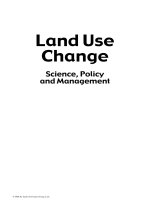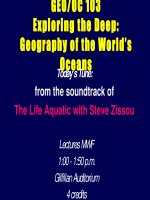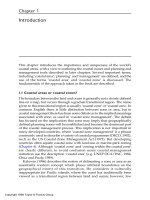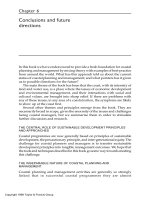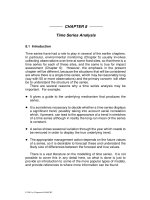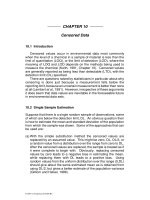Structure and Function in Agroecosystem Design and Management - Chapter 1 ppsx
Bạn đang xem bản rút gọn của tài liệu. Xem và tải ngay bản đầy đủ của tài liệu tại đây (196.94 KB, 22 trang )
Structure and Function
in Agroecosystem
Design and Management
Advances in Agroecology
Series Editor: Clive A. Edwards
Soil Ecology in Sustainable Agricultural Systems,
Lijbert Brussaard and Ronald Ferrera-Cerrato
Biodiversity in Agroecosystems,
Wanda Williams Collins and Calvin O. Qualset
Agroforestry in Sustainable Agricultural Systems,
Louise E. Buck, James P. Lassoie, and Erick C.M. Fernandes
Agroecosystem Sustainability: Developing Practical Strategies,
Stephen R. Gliessman
Advisory Board
Editor-in-Chief
Clive A. Edwards
The Ohio State University, Columbus, OH
Editorial Board
Miguel Altieri
University of California, Berkeley, CA
Lijbert Brussaard
Agricultural University, Wageningen, The Netherlands
David Coleman
University of Georgia, Athens, GA
D.A. Crossley, Jr.
University of Georgia, Athens, GA
Adel El-Titi
Stuttgart, Germany
Charles A. Francis
University of Nebraska, Lincoln, NE
Stephen R. Gliessman
University of California, Santa Cruz
Thurman Grove
North Carolina State University, Raleigh, NC
Maurizio Paoletti
University of Padova, Padova, Italy
David Pimentel
Cornell University, Ithaca, NY
Masae Shiyomi
Ibaraki University, Mito, Japan
Sir Colin R.W. Spedding
Berkshire, England
Moham K. Wali
The Ohio State University, Columbus, OH
Structure and Function
in Agroecosystem
Design and Management
Edited by
Masae Shiyomi
Hiroshi Koizumi
Boca Raton London New York Washington, D.C.
CRC Press
Library of Congress Cataloging-in-Publication Data
Structure and function in agroecosystem design and management / edited by Masae Shiyomi
and Hiroshi Koizumi
p. cm. (Advances in agroecology)
Includes bibliographical references. (p. ).
ISBN 0-8493-0904-2 (alk. paper)
1. Agricultural ecology. 2. Agriculture Environmental aspects. I. Shiyomi, Masae.
II. Koizumi, Hiroshi, Ph.D.III. Series.
S589.7 .S767 2000
338.1
′62 dc21 00-049827
This book contains information obtained from authentic and highly regarded sources. Reprinted material
is quoted with permission, and sources are indicated. A wide variety of references are listed. Reasonable
efforts have been made to publish reliable data and information, but the author and the publisher cannot
assume responsibility for the validity of all materials or for the consequences of their use.
Neither this book nor any part may be reproduced or transmitted in any form or by any means, electronic
or mechanical, including photocopying, microfilming, and recording, or by any information storage or
retrieval system, without prior permission in writing from the publisher.
All rights reserved. Authorization to photocopy items for internal or personal use, or the personal or inter-
nal use of specific clients, may be granted by CRC Press LLC, provided that $.50 per page photocopied
is paid directly to Copyright Clearance Center, 222 Rosewood Drive, Danvers, MA 01923 USA. The fee
code for users of the Transactional Reporting Service is ISBN 0-8493-0904-2/00/$0.00+$.50. The fee is
subject to change without notice. For organizations that have been granted a photocopy license by the
CCC, a separate system of payment has been arranged.
The consent of CRC Press LLC does not extend to copying for general distribution, for promotion, for cre-
ating new works, or for resale. Specific permission must be obtained in writing from CRC Press LLC for
such copying.
Direct all inquiries to CRC Press LLC, 2000 N.W. Corporate Blvd., Boca Raton, Florida 33431.
Trademark Notice: Product or corporate names may be trademarks or registered trademarks, and are used
only for identification and explanation, without intent to infringe.
Visit the CRC Press Web site at www.crcpress.com
© 2001 by CRC Press LLC
No claim to original U.S. Government works
International Standard Book Number 0-8493-0904-2
Library of Congress Card Number 00-049827
Printed in the United States of America 1 2 3 4 5 6 7 8 9 0
Printed on acid-free paper
disclaimer 1/17/01 11:07 AM Page 1
Preface
Today, the world faces many problems. The most important problem is the
population explosion. The population of 2.8 billion around 1945 doubled
during the following 50 years, and it will approximately double again, reach-
ing 10 billion during the next 50 years. This population increase will produce
serious effects on worldwide food consumption and distribution; however, a
sharp production increase in agricultural products cannot be expected.
During the next 50 years, all presently known deposits of natural gas and
petroleum and those to be mined in the future will have been exhausted. This
shortage of fossil fuel will seriously affect agricultural activities.
Present agricultural practices cause environmental problems. Most peo-
ple believe that agriculture is gentle to nature and the earth, as the green of
agricultural fields comforts the human mind. However, the same green
harms the earth. For example, CO
2
from agroecosystems is a greenhouse-
effect gas and nitrogen fertilizer in runoff water from fields may cause
eutrophication of lakes and rivers. These problems are discussed in the chap-
ters that follow.
In this book, biological interactions, matter circulation, and disturbances
operating within the agroecosystems in question will be discussed by 31 sci-
entists working in the fields of agricultural science and applied ecology. A
major purpose of this book is to clarify the structure and function of individ-
ual agroecosystems. Although this book does not attempt to give the entire
picture of these agroecosystems, the authors stress the importance of studies
to elucidate agroecosystems structure and function. These studies will make
it possible to develop alternative types of agriculture in the twenty-first cen-
tury.
The authors live in different parts of the world: China, the Czech
Republic, Finland, Greece, India, Italy, Japan, New Zealand, the U.K., and the
U.S. We hope that such a wide range of experiences contribute to a world-
wide ecdysis of present agriculture and to improvements of other types of
agriculture. If this book can stimulate researchers and students in the fields
of agroecology and agronomy in the world, our major objective will have
been fulfilled.
We express sincere gratitude to the contributors of the 19 chapters and to
Professor Clive A. Edwards, The Ohio State University, for giving us an
opportunity to write and edit this important book.
Masae Shiyomi
Hiroshi Koizumi
920103_CRC20_0904_FM 1/13/01 11:30 AM Page v
920103_CRC20_0904_FM 1/13/01 11:30 AM Page vi
Editors
Masae Shiyomi is a professor of the Faculty of Science at Ibaraki University,
Mito, Japan. He is president of the Japanese Society of Grassland Science and
the Japanese Agricultural Systems Society until 2001. He is a leader in grass-
land science. He and his students are studying energy and matter flow and the
modeling of grassland ecosystems. He is also an applied statistician, and his
ecological work has been deeply enhanced due to his expertise in statistics.
Professor Shiyomi was born in 1938 in Kyoto Prefecture. He graduated
from the University of Tokyo, Faculty of Agriculture in 1961 and received the
degree of Doctor of Agriculture from the University of Tokyo in 1980 with the
thesis: “Mathematical ecology of spatial patterns of biological populations”;
he also received the degree of Doctor of Science from Ibaraki University in
2000, based on his study titled “Spatial pattern of grassland vegetation—
models and methods.” From 1961 to 1978, he worked at the Statistical
Division, the former National Institute of Agricultural Sciences, and the
Ministry of Agriculture, Forestry and Fisheries in Japan. In 1978 he moved to
the Ecology Department of the National Grassland Research Institute and
Plant Ecology Division of the National Institute of Agro-Environmental
Science in the same ministry and continued working there until 1994. In 1994,
he obtained his present position at Ibaraki University.
Professor Shiyomi has obtained various prizes: the Prize of the Japanese
Society of Grassland Science, the Prize of the Minister of Agriculture,
Forestry and Fisheries, the Japan Prize of Agriculture, and the Agriculture
Prize of the Yomiuri Newspaper Company for his studies of systems analy-
sis and statistical ecology in agriculture. He received the title of Honorary
Professor at the Northeast Agricultural University, Harbin, China. He has
written many books and scientific papers. His hobbies include writing
Japanese-style poems and making Japanese-style flower arrangements.
Hiroshi Koizumi is a professor of the Institute for Basin Ecosystem Studies
at Gifu University, Gifu, Japan. He completed his undergraduate and gradu-
ate education at the Department of Biology at Waseda University in Tokyo,
receiving a M.S. degree in 1972 and Doctor of Science degree in 1986 with the
thesis: “The life history of Pylora japonica populations and their light condi-
tions.” As a research assistant he worked for approximately 3 years at the
Institute of Biological Sciences, University of Tsukuba, Japan. Thereafter he
moved to the Plant Ecology Laboratory at the National Institute of Agro-
Environmental Sciences, Ministry of Agriculture, Forestry and Fisheries,
Japan. In 1992 and 1993 he worked at the Crop Science Section of the
Agricultural Research Centre of Finland to conduct cooperative research
between Japan and Finland. In 1998 he obtained his present position at Gifu
University.
Professor Koizumi’s research activities have focused on the ecological
physiology of forest floor plant species. He has been particularly interested
in the light environment and carbon gain of understory herbs associated with
920103_CRC20_0904_FM 1/13/01 11:30 AM Page vii
sunflecks in a forest. He has also been interested in primary productivity and
the efficiency of solar energy utilization in several cropping systems. More
recently, he has extended his research interests to environmental problems
and sustainable land use. He is now focusing on carbon dynamics, budgets,
and sequestrations in agricultural and forest ecosystems.
920103_CRC20_0904_FM 1/13/01 11:30 AM Page viii
Contributors
Hiroshi Amano
Faculty of Horticulture
Chiba University
Matsudo, Japan
Zuozhong Chen
Institute of Botany
Chinese Academy of Sciences
Beijing, People’s Republic of China
Harry Clark
AgResearch Grasslands
Palmerston North, New Zealand
James E. Cooper
Department of Applied Plant
Science
The Queen’s University of Belfast
Newforge Lane
Belfast, Northern Ireland
Xiaoyong Cui
Institute of Botany
Chinese Academy of Sciences
Beijing, People’s Republic of China
Chris Doyle
The Scottish Agricultural College
Auchincruive, Scotland
Grant R. Edwards
Environment Section of
Wye College
University of London
Wye, U.K.
Dimitrios G. Georgakopoulos
Technological Education Institute
of Crete
Heraklio, Greece
Kaija Hakala
Agricultural Research Centre of
Finland
Institute of Crops and Soil Science
Jokioinen, Finland
Daming Huang
Department of Biological Sciences
and Biotechnology
Tsinghua University
Beijing, People’s Republic of China
Hiroyuki Kawashima
Department of Global Agricultural
Sciences
The University of Tokyo
Bunkyo, Tokyo
Japan
920103_CRC20_0904_FM 1/13/01 11:30 AM Page ix
Han Yong Kim
Japan Science and Technology
Corporation and Tohoku
National Agricultural
Experiment Station
Morioka, Iwate
Japan
Ralph Kirkwood
The Scottish Agricultural College
Auchincruive, Scotland
Yuso Kobara
National Institute of Agro-
Environment Sciences
Tsukuba, Japan
Kazuhiko Kobayashi
National Institute of Agro-
Environment Sciences
Tsukuba, Japan
Hiroshi Koizumi
Institute for Basin Ecosystem
Studies
Gifu University
Gifu, Japan
Mark Lieffering
Japan Science and Technology
Corporation and Tohoku
National Agricultural
Experiment Station
Morioka, Iwate
Japan
Nikolaos E. Malathrakis
Technological Education Institute
of Crete
Heraklio, Greece
George Marshall
The Scottish Agricultural College
Auchincruive, Scotland
Bobbie McMichael
USDA-ARS
Plant Stress and Germplasm
Development Unit
Lubbock, Texas
U.S.A.
Neil McRoberts
The Scottish Agricultural College
Auchincruive, Scotland
Jonathan Mitchley
T.H. Huxley School
Imperial College at Wye
Wye, U.K.
920103_CRC20_0904_FM 1/13/01 11:30 AM Page x
Paul C.D. Newton
AgResearch Grasslands
Palmerston North, New Zealand
Maurizio G. Paoletti
Department of Biology
Padova University
Padova, Italy
Julian Park
Department of Agriculture
University of Reading
Reading, U.K.
Masae Shiyomi
Faculty of Science
Ibaraki University
Bunkyo, Mito
Japan
Miloslay
ˇ
Simek
Academy of Sciences of the Czech
Republic and Faculty of
Biological Sciences
University of South Bohemia
Bud
ˇ
ejovice, Czech Republic
Panjab Singh
Indian Agricultural Research
Institute
New Delhi, India
Masako Ueji
National Institute of Agro-
Environment Sciences
Tsukuba, Japan
S.D. Upadhyaya
Jawaharlal Nehru University
Jabalpur, India
John C. Zak
Department of Biological Sciences
Texas Technological University
Lubbock, Texas
U.S.A.
920103_CRC20_0904_FM 1/13/01 11:30 AM Page xi
920103_CRC20_0904_FM 1/13/01 11:30 AM Page xii
Contents
Chapter 1
Introduction
Masae Shiyomi and Hiroshi Koizumi . . . . . . . . . . . . . . . . . . . . . . . . . . . . . . . . . . 1
Part I Biological Interactions in Agroecosystems
Chapter 2
Biodiversity in Agroecosystems and Bioindicators of Environmental Health . . . . 11
Maurizio G. Paoletti
Chapter 3
Species Diversity in Grasslands . . . . . . . . . . . . . . . . . . . . . . . . . . . . . . . . . . . . . . . 45
Jonathan Mitchley
Chapter 4
Ecological Management of Crop-Weed Interactions . . . . . . . . . . . . . . . . . . . . . . . 61
Chris Doyle, Neil McRoberts, Ralph Kirkwood, and George Marshall
Chapter 5
Utilization of Biological Interactions and Matter Cycling in Agriculture . . . . . . . 95
Masae Shiyomi
Chapter 6
Biological Interaction in Tropical Grassland Ecosystems. . . . . . . . . . . . . . . . . . . 113
Panjab Singh and S.D. Upadhyaya
Chapter 7
Agroecology of Arbuscular Mycorrhizal Activity. . . . . . . . . . . . . . . . . . . . . . . . . 145
John C. Zak and Bobbie McMichael
Chapter 8
Species Structure and Abundance of Invertebrate Natural Enemies in
Sustainable Agroecosystems . . . . . . . . . . . . . . . . . . . . . . . . . . . . . . . . . . . . . . . . . 167
Hiroshi Amano
Chapter 9
Plant Diseases and Plant Ecology . . . . . . . . . . . . . . . . . . . . . . . . . . . . . . . . . . . . . 183
Nikolaos E. Malathrakis and Dimitrios G. Georgakopoulos
920103_CRC20_0904_FM 1/13/01 11:30 AM Page xiii
Part II Matter Cycling in Agroecosystems
Chapter 10
Carbon Cycling in Croplands . . . . . . . . . . . . . . . . . . . . . . . . . . . . . . . . . . . . . . . . 207
Hiroshi Koizumi
Chapter 11
Nitrogen Use Efficiency in Temperate Zone Arable Lands. . . . . . . . . . . . . . . . . . 227
Miloslay S
ˇ
imek and James E. Cooper
Chapter 12
Impact of Grazing on the Ecosystems. . . . . . . . . . . . . . . . . . . . . . . . . . . . . . . . . . 253
Daming Huang
Chapter 13
Environmental Fate of Pesticides . . . . . . . . . . . . . . . . . . . . . . . . . . . . . . . . . . . . . 275
Masako Ueji and Yuso Kobara
Chapter 14
The Effect of Elevated Atmospheric CO
2
on Grazed Grasslands . . . . . . . . . . . . . 297
Paul C.D. Newton, Harry Clark, and Grant R. Edwards
Part III Effects of Environmental Changes on the Structure of Agroecosystems
Chapter 15
Impact of Grazing on Soil Properties in Steppe Ecosystems . . . . . . . . . . . . . . . . 315
Zuozhong Chen and Xiaoyong Cui
Chapter 16
Changing Soil Biological Health in Agroecosystems . . . . . . . . . . . . . . . . . . . . . . 335
Julian Park
Chapter 17
Nitrogen Cycle and Agriculture . . . . . . . . . . . . . . . . . . . . . . . . . . . . . . . . . . . . . . 351
Hiroyuki Kawashima
Chapter 18
Growth and Yield of Paddy Rice Under Free-air CO
2
Enrichment . . . . . . . . . . . . 371
Kazuhiko Kobayashi, Mark Lieffering, and Han Yong Kim
Chapter 19
Effects of Climatic Change in Finland on Growth and Yield Formation of
Wheat and Meadow Fescue. . . . . . . . . . . . . . . . . . . . . . . . . . . . . . . . . . . . . . . . . . 397
Kaija Hakala
Index . . . . . . . . . . . . . . . . . . . . . . . . . . . . . . . . . . . . . . . . . . . . . . . . . . . . . . . . . . . 419
920103_CRC20_0904_FM 1/13/01 11:30 AM Page xiv
CHAPTER 1
Introduction
Masae Shiyomi and Hiroshi Koizumi
CONTENTS
Structure and Function of Agroecosystems . . . . . . . . . . . . . . . . . . . . . . . . . . . . 1
Who Is This Book For?. . . . . . . . . . . . . . . . . . . . . . . . . . . . . . . . . . . . . . . . 6
How the Book Is Organized . . . . . . . . . . . . . . . . . . . . . . . . . . . . . . . . . . . 7
References . . . . . . . . . . . . . . . . . . . . . . . . . . . . . . . . . . . . . . . . . . . . . . . . . . . . . . . . 8
STRUCTURE AND FUNCTION OF AGROECOSYSTEMS
The development of agriculture in advanced countries from the 1950s to
the 1970s occurred largely because of enormous increases in the use of fossil
fuel energy. Specifically, it was supported by the increased use of fertilizers
and agrochemicals, which are produced with fossil fuels, agromachinery that
burns large amounts of fuel, and the breeding of new varieties of crops that
are responsive to and compatible with such chemical inputs and cultural
practices (Pimentel et al., 1973). Researchers, too, have promoted this agri-
cultural system by focusing on research that improves crop yield by the direct
utilization of these fertilizers and agrochemical inputs. Indeed, this research
program has been very efficient and has increased both crop and livestock
production and increasingly accelerated the consumption of fertilizers and
agrochemicals. The use of intra- and interspecific interactions and interac-
tions between organisms and the environment, such as climatic factors and
soils, are given little consideration in the current agricultural system.
Modern agricultural practice has viewed these interactions as produc-
tion constraints that must be overcome to make high production possible.
Because the direct effects of fossil fuel energy and its products on agricultural
production have been so powerful, reliable, and dramatic, little attention has
0-8493-0904-2/01/$0.00+$.50
© 2001 by CRC Press LLC
1
920103_CRC20_0904_CH01 1/13/01 10:42 AM Page 1
2 STRUCTURE AND FUNCTION IN AGROECOSYSTEMS DESIGN AND MANAGEMENT
been paid to the complex networks of biological interactions. Figure 1.1 illus-
trates such complex interactions operating in agroecosystems.
1
They include,
for example, competition between phytophagous insects, the effects of insect
pathogens and other natural enemies on these phytophagous species, and
antagonism between microorganisms. The use of agrochemicals has
appeared to make it possible to control insect pests, plant pathogens, and
weeds at sufficiently low levels without regard to the biological functions
and interactions in the agroecosystem. By using fertilizers, it seemed that
high crop yield could be guaranteed without the help of the subtle actions of
soil-borne microorganisms. The direct effects by agrochemicals and fertiliz-
ers are easily understood by farmers, agricultural technicians, and
researchers, while the functions and mechanisms that govern the indirect,
complex effects operating between organisms themselves or the organisms
and the environment are difficult to understand and to utilize efficiently.
The present system of agriculture, which depends on consumption of
tremendous quantities of fossil fuel energy, is now being forced to change to
a system where the interactions between organisms and the environment are
properly used. There are two reasons for this transformation. The first is the
depletion of readily obtainable fossil fuel resources. The second is that con-
sumption of fossil fuels has induced deterioration of the environment.
Two negative aspects of the massive consumption of fossil fuel energy in
modern agriculture should be considered. The rate of increase of crop and
livestock production with increasing inputs has decelerated, as shown in
Figure 1.2. In addition to these reduced marginal rates of return from input
use, it is unlikely that new strains or varieties will be developed that will
respond even more effectively to an increase in inputs. Furthermore, the
direct and indirect effects of continuous inputs of fossil energy have reduced
the diversity of the flora and fauna, further constraining input-based
improvements in production.
Another problem is the broad spatial scale of the effects of modern agri-
culture. The tremendous consumption of fossil energy in agriculture has led
to unprecedented detrimental effects on the global environment and biotic
diversity. The pollution of many ecosystems has been caused by use of agro-
chemicals, especially organochloride pesticides. This pollution expanded as
the pollutants circulated throughout these ecosystems and can now right-
fully be called pollution of the entire earth.
Nitrogen consumption in agriculture has also become an important
global issue. For example, Japan presently imports massive quantities of food
(60% of its food on a calorie basis) and feed (70% of feed) from foreign coun-
tries, and, as a result, the total amount of nitrogen imported into Japan is
1
In this book, the word agroecosystems refers to grassland ecosystems, upland-field ecosystems,
paddy field ecosystems, or areas containing all of them, and an ecosystem contains all living
things and the environment surrounding them, such as solar energy, water, soil, and humans.
920103_CRC20_0904_CH01 1/13/01 10:42 AM Page 2
3
Figure 1.1 Some interrelationships of plants with herbivores, natural enemies of
herbivores, mutualists, and abiotic factors. (Reprinted with permission
from Price, 1984.)
FERTILIZERS
HERBICIDES
FUNGICIDES
MITICIDES
INSECTICIDES
ACID RAIN
PLANT BREEDING
CULTIVATION
PARASITES + PREDATORS
HERBIVORES
MUTUALISTS
MUTUALISTS
PLANT
DECOMPOSERS+SOIL CONDITIONERS
MUTUALISTS
e.g. Mycorrhizal fungi
Root nodule bacteria
e.g. Worms, Ants, Mites
Bacteria, Fungi
e.g. Nematodes
Fungi
Bacteria
e.g. Gut microorganisms
Endosymbionts
e.g. Pollinators
PARASITES
920103_CRC20_0904_CH01 1/13/01 10:42 AM Page 3
4 STRUCTURE AND FUNCTION IN AGROECOSYSTEMS DESIGN AND MANAGEMENT
Figure 1.2 Economics of fertilizer use, showing diminishing returns. (Reprinted with
permission from Edwards, 1990.)
12
11
10
9
8
7
6
5
4
3
2
1
0
0 12345
Dollars returned from fertilizer used
Dollars spent for fertilizer applied
Added cost equals
added return
enormous, as shown in Figure 1.3 (Miwa, 1990). In some areas of Japan, dep-
osition of high concentrations of nitrogen is expected to cause serious pollu-
tion of rivers, lakes, ponds, and groundwater. In southern Japan, livestock
excreta, which is mainly derived from imported feed, amounts to more than
400 kg nitrogen per ha (Tsuiki and Harada, 1997). For comparison, paddy rice
farming requires only 70 to 80 kg nitrogen per hectare per year. The excess
nitrogen from excreta may become an environmental pollutant. We believe
that many developing countries, as well as developed countries, are
presently in a similar situation (see Figure 1.3). Furthermore, farming areas
managed by modern agricultural practices are sources of greenhouse-effect
gasses, including carbon dioxide and methane (Yagi and Minami, 1990;
920103_CRC20_0904_CH01 1/13/01 10:42 AM Page 4
INTRODUCTION 5
Koizumi et al, 1992). Carbon dioxide, which is the most important green-
house-effect gas and a contributor to global warming, is emitted from agro-
ecosystems. Obviously a large amount of carbon dioxide is emitted from
upland crop and fallow fields, and methane is emitted by wetlands, includ-
ing paddy fields, and grassland animals. Thus, modern agricultural prac-
tices, which depend on inputs of fossil fuels, have exerted a variety of
harmful effects on both the local ecosystem and the global biosphere.
Figure 1.3 Nitrogen imported per total agricultural land area; includes both arable
lands and permanent grassland. (Reprinted with permission from Miwa,
1990.)
150 100 50 0 -50
Amount of Nitrogen (kg/ha)
Norway
Denmark
Surinam
France
Thailand
USA
Canada
New Zealand
Chile
Argentina
Peru
Paraguay
Uruguay
Australia
Saudi Arabia
Libya
Mexico
Algeria
Venezuela
Yugoslavia
Czechoslovakia
Spain
Poland
Malaysia
Cuba
UK
Italy
Switzerland
Germany
Israel
Egypt
Korea
Belgium
Netherlands
Japan
920103_CRC20_0904_CH01 1/13/01 10:42 AM Page 5
6 STRUCTURE AND FUNCTION IN AGROECOSYSTEMS DESIGN AND MANAGEMENT
Agriculture can be defined as an industry where products are produced
using the activities of organisms such as crops and livestock. Modern agri-
culture has chosen to rely on fossil energy as the primary means to stimulate
the activities of these organisms. Is it possible to replace current technologies
based on fossil energy with proper interactions operating between
crops/livestock and other organisms to enhance agricultural production? If
the answer is yes, then modern agriculture, which uses only the simplest
biotic responses, can be transformed into an alternative system of agriculture,
in which the use of complex biotic interactions becomes the key technology.
The aim of modern agriculture can be characterized as an optimization
problem in a low dimensional space, where each species represents one
dimension of the space, and production is being optimized. Optimization in
a low dimensional space is expected to be easier to accomplish than opti-
mization in a higher dimensional space because we can more easily rely on
our intuition in a low dimensional space. Because an agricultural system that
relies on complex biotic interactions is expected to have more species that are
functionally important in production than does the current system, it will be
necessary to optimize agricultural production and to minimize adverse envi-
ronmental effects in a multidimensional space. This will be no easy task.
However, many agricultural researchers, especially those who take a com-
prehensive view of agricultural systems, believe that development of such a
system is the key to harmonizing improvements in agricultural production
and preservation of the environment. Edwards (1990) cites 22 types of biotic
interactions (most of which are not particularly complex) that could be con-
sidered as a first step. These examples should be considered a minimal num-
ber of interactions in an agricultural system. In the future, much more
complex interactions operating in agroecosystems will certainly be revealed,
and their structures and functions will be elucidated for use in agriculture.
Who Is This Book For?
This book has been written primarily for graduate students, agronomists,
and all other people who are interested in agriculture. Modern agriculture
consists of scientific knowledge and technology, and agriculture in the new
century will be supported by such highly developed technology. However,
agriculture cannot be developed using technology alone. It must also reflect
the social situation, such as national and local economies and agricultural
policies, and the mode of life of people and their culture. Addressing these
concerns may be more important than developing the technology. Therefore,
a reform in social consciousness, education, policy, and economy is also
required to progress to an alternative, developed system of agriculture.
Although this book does not address these problems, we understand that
such social problems are also a constituent of the structure and function of
agroecosystems and are an important part of developing agriculture.
920103_CRC20_0904_CH01 1/13/01 10:42 AM Page 6
INTRODUCTION 7
This book will not deal with practical techniques, such as organic and
nontillage farming, but with the fundamental, scientific principles of the
structure and function of agriculture. Some parts of this book use mathemat-
ical descriptions, but in most cases they are presented with words and figures
rather than only equations. The equations may be only for scientists who are
strong in mathematics. Mathematical models will also contribute to agricul-
ture in the future. Use of system models with simultaneous differential/dif-
ference equations are especially effective for describing and simulating
complex biotic interactions and matter cycling in agriculture.
How the Book Is Organized
The volume is divided into three parts: Part I deals with biological inter-
actions in agroecosystems; Part II discusses matter cycling in agroecosys-
tems; and Part III addresses the effects of environmental changes on the
structure of agroecosystems. The first 9 chapters (Part I) discuss the present
situation of research on biological interactions in agroecosystems, but they
are not meant to cover this subject completely. The subjects contained in Part
I are as follows: biological diversity in agroecosystems, crop-weed interac-
tions, the importance of studying biological interactions, relationships
between insect pests and natural enemies, and the roles of arbuscular myc-
orrhizal, and interactions between plants and plant diseases. Unfortunately,
we cannot include chapters on intraspecific interactions and food-webs in
this book. Our main target in developing an alternative system of agriculture
is discovery, analysis, and utilization of more complex networks of biotic
interactions operating in agroecosystems. We should point out that the exam-
ples contained in these chapters are simple ones and do not reflect the full
complexity of real systems.
Part II, Chapters 10 to 14, focuses on the structure and functions of mat-
ter cycling in agroecosystems. Matter cycling has two aspects: utilization of
matter cycling in agriculture and its adverse effects on the environment. For
example, carbon dioxide has two effects: acceleration of carbohydrate accu-
mulation in plant bodies and global warming as a greenhouse-effect gas.
Nitrogen cycling also has two aspects. If we can accelerate nitrogen cycling in
grasslands using some techniques, application of only a small amount of
nitrogen can have the same effect as a large application of nitrogen. However,
an application more than the critical limit causes pollution of underground
water and of rivers and lakes. The fate of agrochemicals spread in agro-
ecosystems is another problem caused by modern agriculture. Energy flow in
a grassland ecosystem is also discussed using a system model.
Part III, Chapters 15 to 19, addresses the effect of environmental changes
on the structure of agroecosystems. This part reviews how local and global
changes in various environments affect the soil properties, biological diver-
sity, and nitrogen cycling in food production. Unfortunately, we cannot treat
920103_CRC20_0904_CH01 1/13/01 10:42 AM Page 7
8 STRUCTURE AND FUNCTION IN AGROECOSYSTEMS DESIGN AND MANAGEMENT
the problems of biological invasion in this part of the book. There is a danger,
all over the world, that invading organisms disturb new habitats, drive the
original habitants away, and damage food production.
This book is primarily based on concepts of ecology and ecosystems,
which play important roles in agriculture. Thinking about and carefully
observing agriculture in terms of ecological theory will become increasingly
important in the twenty-first century. We hope that the readers will enjoy
reading this book as much as we enjoyed writing it.
REFERENCES
Edwards, C.A. 1990, The importance of integration in sustainable agricultural sys-
tems. In: Eds. C.A. Edwards, R. Lal, P. Madden, R.H. Miller and G. House,
Sustainable Agricultural Systems, 249–264. Soil and Water Conservation Society,
Iowa.
Koizumi, H., Y. Usami, and M. Satoh 1992, Energy flow, carbon dynamics and fertil-
ity in three double-cropping agro-ecosystems in Japan. In: Eds. M. Shiyomi,
E. Yano, H. Koizumi, D.A. Andow, and N. Hokyo,
Ecological Processes in
Agroecosystems,
157–171. Yokendo Publishers, Tokyo.
Miwa, E. 1990, Global nutrient flow and degradation of soils and environment. In:
Transactions, 14th International Congress of Soil Science Vol. 5, 271–276. Japanese
Society of Soil Science and Plant Nutrition, Tokyo.
Pimentel, D., L.E. Hurd, A.C. Bellotti, M.J. Forster, I.N. Oka, O.D. Schles, and R.J.
Whitman 1973, Food production and the energy crisis.
Science 182:443–449.
Price, P.W. 1984,
Insect Ecology (2nd edition), 10. Wiley-Interscience, New York.
Tsuiki, M. and Y. Harada 1996, Quantitative estimation of nutrient flow in dairy farm.
I. Nitrogen flow.
J. Jpn. Agric. Syst. Soc. 12:103–107.
Yagi, K. and K. Minami 1990, Effects of organic matter application on methane emis-
sion from Japanese paddy field. In:
Soils and the Greenhouse Effect, 467–473. Wiley,
New York.
920103_CRC20_0904_CH01 1/13/01 10:42 AM Page 8
